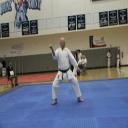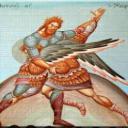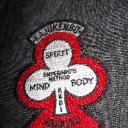Yahoo Answers is shutting down on May 4th, 2021 (Eastern Time) and beginning April 20th, 2021 (Eastern Time) the Yahoo Answers website will be in read-only mode. There will be no changes to other Yahoo properties or services, or your Yahoo account. You can find more information about the Yahoo Answers shutdown and how to download your data on this help page.
Trending News
What does this mean to you?
In many styles, you are instructed in basic training to begin by stepping back and performing a downward parry (gedan barai). What does this mean, this sequence of movements? Why is it done, and what can you do with it?
I was hoping for some beginners (up to 10 or so years of training).
Of course you folks know I can parry that kick. or toss a broken person way too hard on the ground, or just break his arm with that move, plus much more pretty bad stuff.
Any of you younger guys know how to break an arm defending a high of mid level punch with gedan barai?
I was hoping for some beginners (up to 10 or so years of training).
Of course you folks know I can parry that kick. or toss a broken person way too hard on the ground, or just break his arm with that move, plus much more pretty bad stuff.
Any of you younger guys know how to break an arm defending a high of mid level punch with gedan barai?
I was hoping for some beginners (up to 10 or so years of training).
Of course you folks know I can parry that kick. or toss a broken person way too hard on the ground, or just break his arm with that move, plus much more pretty bad stuff.
Any of you younger guys know how to break an arm defending a high of mid level punch with gedan barai?
Alex: the study of bunkai shows us many things. On is that this movement is ill suited to it's declared purpose.
Often it is an attack as well, and what is that retracting hand up to?
I hadn't intended this to revert into a beginner's lesson for you.
Alex: the study of bunkai shows us many things. On is that this movement is ill suited to it's declared purpose.
Often it is an attack as well, and what is that retracting hand up to?
I hadn't intended this to revert into a beginner's lesson for you.
9 Answers
- KokoroLv 78 years agoFavorite Answer
the difference between a beginner technique and an advance technique is the application
the beginner technique you are taught to perry a low lever attack, ie, a front kick or a low punch.
as you advance it becomes much more, if you still just interpreter as using the end points of the technique then your first motion becomes the perry and strike at the same time and the follow through can be a strike, so you can perry a mid to high level attack and strike with the opposite arm and in the follow through strike again.
(hope you can follow that description)
i'm not going to go into details since it would be to much to type, but if you start using the movements between the end points as well you can get a whole flurry of techniques out of it for example the technique can also be used as a trapping technique, arm bar, finger lock, as well as reversals for various techniques such as wrist grabs and joint locks, if you turn with the movement it start becoming a throw.
the applicants to that one movement can go into the hundreds. after 30yrs in karate and performing that one technique i am still learning applications for it.
my one friend insist when he does a class that is the only technique we can use to defend ourselves, regardless of the on coming attack.
stance also can be used in applications, but that opens up a whole other slew of techniques they can be
edit:>
awww poor hi did i upset your something perhaps you need a blanky, and a warm bottle of milk will that help you bused feelings. do you need me to sing you a bed time lullaby as well.
the true history of HI
a few days ago hi: was taking kyokushin karate then the next day he went off on his rants. all he does is lie, rant, and insult people. such a sad little child, i think he needs some one to tuck him in and sing him a lullaby or something, and perhaps a bottle of warm milk will help him too.
http://answers.yahoo.com/question/index?qid=201306...
if you notice the accounts have the same number of points and were created the same day, as well as both the accounts on that question and hi's account having the same exact link so it is clearly him, i'm sure he will make up some grand excuse now about this whole question he posted. it will be quite amusing even.
***EDIT:>
alex: you are looking at the finished movement of down guard only. not the big picture, and that is not your fault, just seeing the obvious movement is not the only application.
if you look at the first motion of down guard, your lead hand comes up by your ear and your other hand comes across. the hand that shot up towards your ear that parrys the high punch or evan a mid-level punch.... if you add some foot work into it you can parry a haymaker as well.
as for the arm break or arm bar, its all down in between the start and finish motions, grabbing and trapping the wrist, and then coming across with the other arm and snapping their arm... it might not be easy to follow with my short description
i can spend months just on down guard applications and never go over the same one twice
about 1:10 is the high perry application i was talking about for gedan barai
http://www.youtube.com/watch?v=efqiHKGIBzc
and here is a few others i found that was interesting as well
http://www.youtube.com/watch?v=XoVVyoTTtUc
http://www.youtube.com/watch?v=IsXfjHkZmLc
Edit and that's where your wrong Alex it's all gedan barai. You just don't get it because your close minded.
Also there are 3 types of gedan barai, and each style has different was of doing the technique
edit:> lmao dave what do you expect from little toddlers full sentence. lmao. he is cranky because he missed his nappy. poor little toddler hi
Source(s): 30+yrs ma - Karate DaveLv 68 years ago
Not a whole lot needs to be added to Kokoro's answer. As already said gedan barai can be used from a wrist release to a throw, to some very interesting kyusho points and many many things in between.
If this technique was just a block, why does the back hand extend first? Could it be that, that is the hand that actually intercepts the incoming attack, parrying it and setting up the "front" hand to strike.
Why would the creators of these kata include a 270 degree turn, usually followed by a gedan barai? One simple explanation is the the turn and "down block" become a throw. If I was actually trying to block something coming in from the side I would not turn almost all the way around, I would take the 90 degree turn for quicker and easier movement, but you never see that in kata, so then that must mean that the basic interpretation is missing something.
Kata and the martial arts do not teach you to fight. They teach you effective reflexes that manifest when you need them without thinking, IF you have trained properly. There are no blocks in karate. The terms we use for what we teach beginners as blocks really are not Uke the term most often associated with block does not mean that in any way. Uke translates closer to " to receive", that implies that it is grasping or taking something not blocking or stopping. Barai translates closer to sweeping than anything else. These techniques are grappling or grasping techniques and strikes not blocks.
@ Kokoro, you must have really gotten to "Hi", he / she / or it has been reduced to babbling and sputtering.
Source(s): 31 years MA - GeorgieLv 58 years ago
This is from Shotokan Karate. The most common question about it is the wide front stance. Its wide front stance is taking a good use later on movement when the stances are getting closer. For example to move a bit forward when you kizami zuki (Jab punch).
About the rest, an application of the gedan barai is for receiving a kick. The other hand is on a ready to punch from the hips position, so it is also a start for a punch, either a reverse straight punch from the same position, either an Oi zuki (punch while stepping forward)
Every move in Karate can be applied in several ways. A strike while the opponent is on the movement, a turning around and a throw, grabbing the leg, e.t.c . are all to start or to be found in that move.
- possumLv 78 years ago
I can't fathom why anyone would want to block a kick, or, strike the kicking leg with a forearm or hammerfist of sorts to an incoming kick. The physics of the movements of both the attacker and defender always favor the attacker. Even in sport sparring, when either or both are wearing gear, and even when the kicker isn't going for a knock-out kick or a disabling kick, the potential to walk away with bruises is very high. Striking a leg with the forearm is fine, but movements are vectors, and adding the block movement's vector to an incoming kick's vector result in a very strong clash that is liable to result in injury to the defender. Perhaps, this is acceptable when nothing else seems viable, but honestly, I doubt a low block was ever intended to be used against a kick.
Perhaps, the movement can be better represented that the blocking hand contains a weapon - like a stick or pipe.
Or that the lowering "block" is an attempt to release from a shoulder, throat, or collar grab.
That one is stepping back suggests that the opponent could be behind us, and so the low block is a throw of the person behind us.
Often, the other hand is pulling back; maybe that is a disarm of a weapon and the step back assists in the disarm by creating more distance. The low block could be a guard against the opponent attempting to retrieve said taken weapon.
The movement could be interpreted as a kokyu nage: the pulling hand pulls the opponent off balance while the lowering arm causes the opponent to fall straight down (like a throw, only in-place).
Stepping back is sometimes seen as a defensive action, and so, this can be seen as a means of getting off the line and creating distance to avoid an incoming strike. This could allow the opponent to be pulled off balance in the vector of his strike, thereby allowing the defender to take his balance and neutralize the strike.
Several principles are demonstrated: getting off the line, rooting, centering, balance points, that stepping back is usually a defensive posture (while the reverse - step forward - is usually an offensive posture).
- How do you think about the answers? You can sign in to vote the answer.
- 8 years ago
You start off beginners with stepping back because it gives them more time to complete the block or parry and to then counter without maybe hitting their partner. The timing aspect of their block or parry intersecting with the kick is not quite so critical. Eventually they should also practice and learn to instead step forward at times which puts them closer to their partner and able to counter more easily as they get more advanced in their skills and ability.
Gedan barai is a low block or parry and not meant for defending against attacks to the midsection or higher like to the face. Other blocks are used for defending against attacks to those areas.
- Anonymous8 years ago
I have 7 years of training in Shotokan so far, that is a very interesting question. First of all, let's break the move down into bunkai. Or in other words: Analysis. The mechanics is that you
1. Interlock your arms,
2. lower your center of gravity,
3.put it back by a step,
4.then sweep the frontal arm downwards while the other arm contracts in an opposing direction.
5. Complete execution by twisting the body.
6. The left arm is left in front.
I don't really think the techniques matter that much, it's better to focus in on details of twists, motion, anatomical geometry, stability changes, and angles, rather to look towards everything as parries, punch, arm bar or locks.
Geidan Barai certainly is not taught as a parry in my dojo, due to the fact that the karate instructor taught that by using one arm to sweep the lower body in defence is both too slow and reveals openings in the upper body for another attacker to potentially devaste areas near the eyes, temples, neck, mastoid process and who knows...... She taught that it would be much more logical to rely on instinct and just move away, jerk back from a hit to the lower section and counter, or just drop your elbow down and move out immediately.
Let's discuss the ouyo, or the situation that the analysed details could apply to. Please forgive me if I'm not correct, but I am trained to analyse movements by the nature and physics, rather than looking at techniques in it.
In the first step, the interlocking the arm was interpreted as a double block in my dojo, against a really wild hook in close quarters, while the defender grabs and twists the testicles. Or as others say it could be used to parry a straight attack to the head, while the bottom arm attacks the solar plexus similar to a technique in Pinan Godan.
The second as well as the third procedure could suggest that this Geidan Barai was designed as a grip break for a really heavy wrist grab. Another instructor in my school has the view that karate never teaches you to chamber your punches at the waist, his belief is the 2 hands theory, that it's either a trap, a grab or lock. Both hands are put to use, no hand is left in a position that could be telegraphed...The main priniciple he teaches is that you attack with the body part closes to your opponent while other body parts supports it. He never teaches us to drop into a stance in a fight, as he says that your opponent will see it, and they'll react to your posture and have the response to fight, take a weapon, or call buddies. He always teaches us to put on a fence like posture in a confrontation and once the thing hits the fan, just attack without warning.
Therefore, he stress that instead of getting into a position of attack, the move is to lower you center of gravity so someone cannot suddenly pull you off balance in a static wrist grab. Raise the other arm and sweep off the opponent's grabbing wrist, while jerking the hand back, which is aided by the momentum going backwards when the defender takes a step back to raising back the fence. He also teaches another variation where you raise the sweeping arm, deliver a backfist, then break free.
As well as this, number 5 usually involve a turn of the body, could this be some kind of kuzushi waza, or some kind of evasion in grappling attacks to shift balance. Or perhaps to add momentum to a groin attack, while the other arm is holding the opponent's left side to a point beyond his base, and really, just hit hard in the groin while he can't repercuss without re-positioning.
Also, after reading Rex Applegate's books, I am left to wonder if the left arm, and not the right arm being out, is there to really protect your vital organs on the left side.......
What frustrates me is not doing the kata, but the point my sensei makes that I have to interpret body mechanics and then regurgitate them in the correct situation which require those mechanics as opposed to just thinking techniques. I just can't seem to find a meaning for those little turns!
Added: If anyone can help me or give me some tips regarding how to interpret those mechanics, I would be very grateful! Thanks!
- kajukatLv 58 years ago
It can be a block to a front kick. I'm over 50 now, so my memory is not the same, and I get the numbers of our techniques mixed up now. I think that is our Emperado Method Basic Number 6. If someone else does Kajukenbo here, and notices I got the numbers mixed up, please do correct me.
You are standing in a neutral stance facing opponent. Opponent sucker front kicks you with a right leg front kick to the groin. Step forward at a slight angle with the right foot, simultaneously hammer fist the opponent's outer calf with your right hand. Right arm revolves around opponent's calf and catches calf on your inner elbow. Sink into horse stance while doing left dropping elbow into opponent's thigh. Right arm releases calf to palm strike the opponent's groin while the left hand simultaneously knife hand's the throat.
There is more moves in the sequence, but I wanted to let people know that the downward block can be used as a block to a front kick. Kajukenbo just has a confusing way of naming the techniques.
Source(s): Arnis, Kajukenbo - Anonymous8 years ago
Defending a high punch with a downward block? Unless your attacker is a midget I don't see how that could possibly work.
Breaking your attacker's arm with a downward block? You must be leaving out several steps of that technique!
Oy vey. First, most of the "applications" demonstrated in those videos (and others I watched) bear no relation to the actual gedan barai movement. Basically they are saying "Look, in this series of movements my arm moves in a downward motion at some point. See, it's gedan barai!" No, it isn't. Second, while most of the applications shown work very well with a cooperating partner, it's amazing how you never see any of them used in actual fights. Half of karate is fantasy. The other half is kickboxing.
Let the thumbs down commence!
- jwbulldogsLv 78 years ago
Kokoro did a great job of giving details of how this is used. We teach beginners its a low block or a leg block. But it really is a strike, throw, arm bar, etc.
In one step kumite it is done to teach some basic concepts like how to read the attackers motion, distance timing, and how to counter.
Source(s): Martial Arts since 1982









